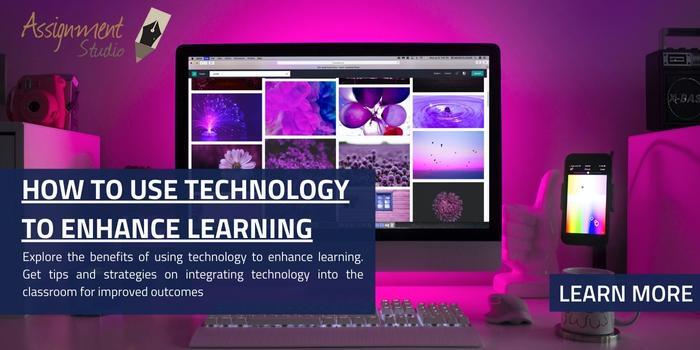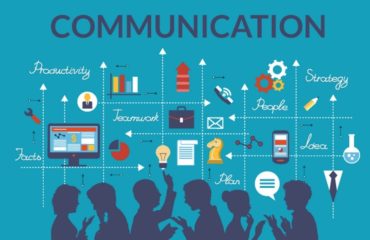
Children and young adults have now become more accustomed with screens and are in a habit of absorbing information visually. Since their entertainment is also in the form of visual media and graphical representation, their learning content should also be just as engaging. That way, teachers and professors can make sure that their classrooms are following modern standards and making the students equipped with the skills to operate technology that will help them in their professions as well.
Table of Contents
Advantages of technology in learning
- More engagement: There’s no doubt that due to the limited vocabulary of young people, they find it much easier to absorb information in the form of pictures and other visuals. Explaining a scientific concept with the aid of five diagrams is much more complex than just showing a short gif of any process being taught in class. According to research by Pauline Dewan (‘Words Versus Pictures: Leveraging the Research on Visual Communication’ published in the Canadian Journal of Library and Information Practice and Research), memory formed with words is actually stored with a single code whereas pictures are stored with two codes- visual and verbal- so it is easier to recall
- Tech literacy: Making your students comfortable with technology is very important for their career because it enables them to confidently handle the softwares and machines. The basics of word processing, spreadsheets, data processing, troubleshooting, etc. should be known so that they do not have to learn it from scratch when they get jobs
- Collaborative learning: As everyone is used to sharing and talking about their experience on social media, it is useful to integrate it in the world of learning as well. Students can sign up on educational social websites or educational apps where they can collaborate and discuss ideas they learned in class. Students love to challenge each other when preparing for tests and discussing the concepts together. Imagine students from all over the world being able to share their curiosity with each other- it can even give birth to new ideas
Using technology for learning
Using technology for education can be a slow transition for educational institutes and teachers because most people see it as a distraction. It is also assumed that technology used in classrooms is expensive which discourages schools from introducing it in their learning process. The basic impediment in the use of tech in education is the conservative way of approaching the learning process. Resisting change would not be a feasible option because the advantages of using tech are far more than the disadvantages.
Types of technology for education
Here are some Edtech categorised by the kind of learning they aid:
- Learning Management systems: Learning Management Systems (LMS) became extremely useful during the pandemic for distance learning purposes. Platforms like Google Classroom, Blackboard, Moodle, etc. are all included in this category. These softwares can be either used inside the classroom (where teachers and students have their own displays) or for distance learning. Teachers can deliver live lectures, create lessons and upload them, upload different kinds of assessment tests, monitor student progress and communicate with them. This way, LMS makes both synchronous and asynchronous types of learning possible
- Gamification: Teaching in a video game format is an excellent way to motivate students. With the digital rewards and the ability to visualise the learning progress encourages students to actively learn and compete with each other for higher scores
- Virtual reality: Virtual Reality (VR) and Augmented Reality (AR) are both incredible ways of bringing the student’s imagination into the classroom. By making them virtually tour ancient civilisations in history class or observe landscapes during geography, they can learn and remember easily. This will also spark their curiosity
- Smart classrooms: This refers to classrooms where teachers and students are both connected by tablets, laptops, digital whiteboards, projectors, etc. Multimedia lectures can be used to teach any subject and students can also interact with the content or edit it for their own use during lectures
Integration of Artificial Intelligence in e-learning
AI use for learning is still very new in the e-learning process but it is a transformative approach for the education industry which considerably speeds up learning:
- Personalised experience: The AI technology customises the online learning experience as the algorithm keeps getting more data about the response of the student to the lesson delivered. Different types of learning methods are employed until the most optimum way is found for the student- this is known as adaptive learning or personalised learning
- AI bots: These are chatbots that the student can talk to for lesson-related queries. These bots can guide students to the right link or resource they need and save the teacher’s time
- Grading and assessments: AI can check plagiarism in student assignments and tests by comparing the handwriting and content on the internet. They can also grade the paper with the neural matching abilities
- Increased accessibility: One thing that AI tools can do is make the lesson content more accessible for disabled students and students studying in other languages. This way a lot of barriers can be removed and everyone can get equal access to education
Choosing the right tools for your elearning
When you’re paying for an elearning platform as a teacher, you should properly search if it fits your needs by considering the following things
Ease of use: Depending on your expertise, different kinds of softwares will have different levels of user-friendliness. Take a look at the interface and see if there is no redundancy of features that confuses and distracts you. The features should meet your needs and you should be able to get the hang of it in a short time
Essential tools: The important tools include built-in ability to record and edit lectures, templates for content and stimulated environments for ease of learning
Versatile: The kind of content you will need to create for science will be different from that of maths or arts so make sure it can cater to all kinds of content
Time of development: When any changes are required in the system, the development time should not be too much
Resource library: It is extremely useful if the system can store all the content in the library as you create it. It will be easy for students to access it too
Languages: In order for students from all kinds of backgrounds to access the content, the system should be able to switch the language
Budget constraints: Invest in a system that is easily affordable and dependable as well. Do not overspend on something fancy and regret later
The role of teachers in promoting technology-enhanced learning
Teachers can help promote Edtech (educational technology) by two processes- by creating quality content for students and by the way they incorporate technology in the classroom. This depends on how interactive the teacher makes the learning process, as well as their knowledge about the content creation tools and their own subject.
Teachers should be trained about how to use the software and incorporate the feedback they get from students regarding the content. When they are in the classroom, the interaction between the students and teachers is the most important factor for how well the technology is used in the classroom for learning. If they can motivate the students (for example, or gamification) and help them open up for collaboration, they will learn to use it actively.
Best practices for effective use of technology in education
In order for teachers to effectively use technology they need to be digitally literate and have a positive attitude towards learning digitally. For this, they should be given the proper required training in order to be able to design the content for lectures.
Technology can be used in the best possible way if students are taught to be self-learners because the content and activities are already pre-designed and all they need to do is collaborate with the instructor and other students.
The different learning styles of the students should be taken into consideration because the students can only be assessed if they have all properly understood the lesson in the classroom. Using labels and ranks does not motivate students as much as creating excitement around the course content does.
Future of technology in education
As technology evolves and there are more interactive softwares, the classroom experience will change accordingly. If 3D printers and mixed reality experiences become more accessible, learners with a more tactile method of learning will be able to retain information too. Predictive analytics can also be used to observe the progress and predict students’ grades so that their parents can be notified about their learning issues. There are many exploration and skill-building apps available and these will only increase in amount. This will promote the environment where every child is becoming a self-learner and ready to solve problems of the real-world.
Technology makes the information easily available but the role of the teachers is still there and they have to promote critical thinking in the classroom despite the presence of all these modern tools.








